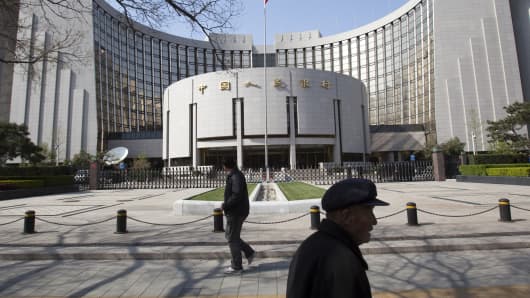Shortly after the central bank announced an addition to its regulatory tool kit, the Short-term Liquidity Operation (SLO), analysts started wondering if this meant small-scale quantitative easing.
There is debate over that issue, but most analysts agreed that the new tool will have a significant impact on current principal regulatory instruments: banks' reserve-requirement ratio (RRR) and deposit and lending interest rates.
In its announcement on January 18, the central bank said the new operation would mostly use repurchase agreements or reverse repurchase agreements that mature in seven days or less to supplement existing open market operation tools, which comprise central bills, repos and reverse repos.
The goal is to smooth out sharp liquidity fluctuations and stabilize short-term interest rates, the bank said.
Twelve banks, including the Big Four state-owned banks, have been named as participants in the SLO scheme.
(Read More: Goldman Sachs Backs Down on UK Bonus Plan)
The move is very likely to create a situation where the central bank lends generously at low cost to commercial banks, which in turn can pump the market with liquidity, Xu Hanfei, Guangfa Securities' chief analyst, wrote in a commentary.
He was not alone in predicting a loosening credit environment. Across the financial and business community, mini QE, a reference to the predicted impact of SLOs, has become a buzzword.
A Five-Day Workweek
Analysts pointed to the fact that the central bank had been using reverse repos to flush the inter-bank market with liquidity in the past several months. It was possible it would continue doing so with the new tool, they said.
However, a source close to the central bank said they were drawing a conclusion too soon. A key difference between QE and SLO, he argued, is that the former is engineered to increase credit supply while the latter can either tighten or relax liquidity.
Indeed, SLO is a two-way valve. The central bank can choose either to conduct repos to mop up liquidity in the market or have it the other way round with reverse repos, the source said.
A state-owned bank's capital trader also said comparing SLOs to QE overstretched the point, saying that the new tool was only designed to strengthen the central bank's ability to prevent sharp liquidity fluctuations and stabilize short-term interest rates.
Like central bills, SLOs are scheduled on Mondays, Wednesdays and Fridays. The central bank can determine whether to take the action and its size and maturity.
The timing of SLOs complements that for repos and reverse repos, which are on Tuesdays and Thursdays.
That is important because now the bank can regulate money supply with short-term tools on all weekdays, the source close to the central bank said.
Tools of the Trade
Calls have been raised for such new tools because traditional regulatory instruments have failed to catch up with the changing environment.
The central bank's researcher, Wu Ge, for example, said in an October paper that a more balanced international payment account had fundamentally altered the condition for funds outstanding for foreign exchange, the amount of yuan put into the domestic market equivalent to foreign exchange taken in by banks during the same time.


